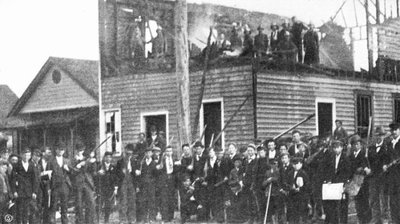
Race Riots in Wilmington, North Carolina, 1898. via Library of Congress
For a Google doc of this lesson, click here . (Note: You will need to make a copy of the Google doc to edit it.)
This lesson looks at four insurrections that have taken place in U.S. history, which may help your students understand some of the historical context of the January 6th attack on the Capitol building in Washington D.C.
You might also want to have your students research other riots that have taken place in American history, including the NYC Draft Riots and the Tulsa Massacre.
Subjects
U.S. History, Social Studies, Civics
Estimated Time
One 50-minute class period
Grade Level
7–12
Objective
To read about previous insurrections in U.S. history and analyze the roles race and class have played.
Starting Off
Watch this NewsHour video , "There’s an ongoing battle of words to describe Jan 6, 2021. Here’s why it matters." Ask your students what they have heard Wednesday's events called in the news media? At home? What do they call the events that took place at the Capitol? Was it an insurrection? A coup? Should we call it terrorism? Domestic terrorism? A protest gone awry?
NewsHour's Christopher Booker spoke to Joanne Freeman, a history professor at Yale University, about why words used to describe the event today will shape its history.
Four Insurrections
Directions: Read about the following insurrections that have taken place in U.S. history. After the mob violence at the Capitol on January 6th, have your students answer this essential question:
How are race and class connected to insurrections in the history of our country?
Shays’ Rebellion, January 1786
Following the American Revolution, taxation was instituted to repay the war debt, and it landed severely on the farmers of Massachusetts. Farmers who could not pay their taxes were losing their property to foreclosures. In September 1786, a small group of those citizens organized protest gatherings across the state. Revolutionary War hero Daniel Shays led these armed rebels and massed at county courts to stop them from processing the seizures of farms.
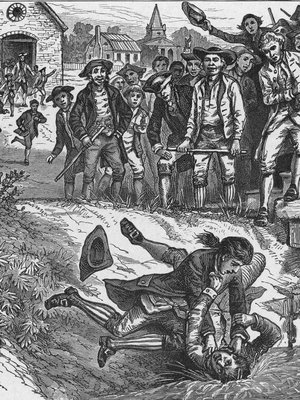
An engraved illustration of fighting during Shays' Rebellion of 1786, circa 1850. Hulton Archive/Getty Images
A group of protestors calling themselves the “Regulators” stormed the courthouse at Northampton to prevent it from convening. Job Shattuck, a farmer from Groton, led an armed confrontation with tax collectors to prevent them from foreclosing on neighbors. In Uxbridge, a mob even seized confiscated property and returned it to the former owners.
The Massachusetts legislature did not address debt relief. Governor James Bowdoin called up 1,200 members of the state militia, fearing that the Shays groups would attack state buildings. As predicted, 1,500 of Shays’ protesters attacked the federal armory at Springfield and were repelled by the militia, leaving four dead and 20 wounded. The main rebellion was permanently crushed by the militia forces at its camp in the town of Petersham, and most of the Shays leaders were captured.
One result of Shays’ Rebellion was the recognition of the need for a stronger central government, which would inspire the abandonment of the Articles of Confederation in favor of the Constitution. Violence provoked by taxes did not end then, however, and the Whiskey Rebellion over the tax on whiskey, which heavily punished farmers on the western frontier who distilled their grain, followed just five years later.
- Learn more about Shays' Rebellion at NPR here .
- Watch this story about the 1995 Oklahoma City terrorist bombing which references Shays' Rebellion at NewsHour here .
The Memphis and New Orleans Riots of 1866
The Memphis riot in May of 1866 began with white citizen aggression, especially from policemen, toward commissioned African American soldiers in Memphis. As the Freedmen’s Bureau report on the slaughter of over 90 citizens in a camp of formerly enslaved persons observed:
"The remote cause of the riot as it appears to us is a bitterness of feeling which has always existed between the low whites & blacks, both of whom have long advanced rival claims for superiority, both being as degraded as human beings can possibly be." — Report of an investigation of the cause, origin and results of the late riots in the city of Memphis made by Col. Charles F. Johnson, et al

Memphis riot, 1866.
Word had gone out that a scuffle had occurred between the Black soldiers and white policemen. After hearing those reports, Union General George Stoneman disarmed the Black soldiers and locked them in their barracks. They could not defend the camp of newly freed people nearby, and a white mob attacked unarmed men, women, children and Northern missionaries and teachers in the camp.
Former Confederates, still stinging from the recent defeat of the Confederacy, were angered by competition for work with former slaves and sought to deny equal political and legal rights to those newly freed.
In July a second riot occurred in New Orleans when a peaceful march of Black men toward the Mechanics Institute was attacked by a white mob, whose feelings were similar to those of the men in Memphis.
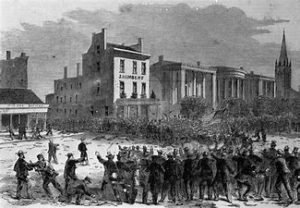
New Orleans riot, 1866.
The result of these bloody uprisings of former Confederates was the reaction in the Congress that the rights of former slaves needed to be more strenuously protected. The "Radical Republicans" (those determined to ensure equal rights for newly freed Black citizens) then passed a Civil Rights Bill and the 14 th Amendment, guaranteeing citizenship and the right to vote and hold office for those formerly enslaved.
- Learn more about the 1866 New Orleans riot in this NPR piece .
- Learn more about the Memphis Riots of 1866 here .
Wilmington Coup D’État of 1898
The Wilmington massacre of 1898 was a mass riot and insurrection carried out by white supremacists in Wilmington, North Carolina, on Thursday, November 10, 1898. It came to be seen as a coup d'état, the violent overthrow of a duly elected government, by a group of white supremacists. Around 2,000 white men were able to overthrow the elected local government. They threw officials out of their offices and destroyed Black businesses, including the only Black newspaper in Wilmington. Up to 300 people were killed. The direct removal and replacement of elected officials by an unelected mob is unique in American history.
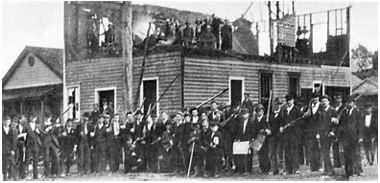
Mob posing by the ruins of The Daily Record (Library of Congress)
The role of newspapers in the Wilmington Insurrection is also remarkable. Josephus Daniels published the largest paper in North Carolina, The News and Observer, and he printed fabricated accounts of what he called the “Negro Menace,” including stories and cartoons of Black men attacking white women. He claimed that the Fusion political party would take over North Carolina as a “Black political party,” even though it was composed mainly of white men.
Another North Carolina paper printed a speech from Rebecca Felton, a journalist and future U.S. Senator, who said she would support lynching a Black man every day if it meant protecting white women. Alex Manly, editor of The Daily Record, a Black newspaper, attacked the myth of white women being violated by “big burly Black brutes.” He reminded readers that the rape of powerless Black women by white men was the real problem. “Mrs. Felton must…teach your men purity.”
The Wilmington coup d'état inaugurated an era of severe Jim Crow segregation in the South and the disenfranchisement of African American voters.
- Learn more about the Wilmington coup d'état at the Atlantic here and with this Vox video here .
- Listen and watch the WHQR's videos and podcast coverage here .
Ocoee Riot, November 3, 1920
This text is based on author Zora Neale Hurston's work, who wrote an account of the massacre for the Works Progress Administration in 1939, which was published by Essence magazine 50 years later.
Many insurrections in the United States were directly caused by vicious racism. In 1921, the largest of these, the Tulsa, Oklahoma Massacre destroyed the most prosperous Black community in the country. Even in smaller towns, like Ocoee, Florida, insurrections killed and devastated Black communities.
On Election Day, November 3, 1920, a riot broke out at Ocoee, Florida, following a disturbance at the polls. Mobs surrounded the Black neighborhoods in town and burned 30 houses and two churches, forcing men, women, and children back into the flames. In all, some 35 Black people were killed.
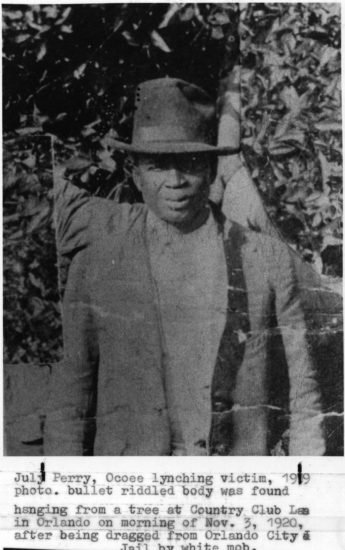
Julius ‘July’ Perry Ocoee Massacre. Source: University of Florida.
Mose Norman, a prosperous orange grove owner and the town’s most prominent Black citizen, had gone to downtown Ocoee to vote on November 3, 1920, and was harassed by poor whites from Winter Garden who had come to town to threaten the blacks to keep away from the polls. After he was struck and driven off, he drove to Orlando to report what was happening at the polls in Ocoee to a lawyer. The lawyer advised Norman to write down names and details — who were the whites interfering with the vote? Which Black people had been denied their vote? Norman went back to Ocoee to observe the polling site.
Mose Norman happened to have a shotgun under the seat of his car, which he kept for hunting and never touched that day. Some of the disorderly whites from Winter Garden found it there, and they beat him up. Other black men were assaulted, one was allegedly castrated, and Black churches were torched. At this point, many Black residents of Ocoee decided to flee the town or hide. Some hid in barns and under their houses.
Someone told the unruly mob that Mose Norman was holed up on July Perry's farm; actually, Norman had left Ocoee altogether. The mob headed toward the Perry place. The Perrys' sons and neighbors were hiding in the surrounding groves, but Perry himself, his wife and his daughter stayed in the house. Perry held his high-powered rifle ready to defend his family. When the mob rushed his house, Perry fired the rifle and killed two white men.
Eventually the rioters lynched July Perry, dragging him to his death behind an automobile, and left his body hanging on a telephone pole. They set fire to the entire black community of Ocoee and shot and burned to death an untold total of black residents. The conflict spread to Orlando, Apopka and Winter Garden itself. For many succeeding decades, Black families were not permitted to live in Ocoee, and for many more, they chose not to.
- Read the Orlando Sentinel's report on the Ocoee riot here and Zinn Education Project's article here .
Protests at UC Berkeley, Free Speech Movement 1965
On Dec. 2, 1965, between 1,500 and 4,000 students at the Berkeley campus of the University of California rushed into Sproul Hall and took it over, claiming that the administration of the university had restricted students’ rights to free speech at campus rallies. Some students had been singled out for harsher discipline than others.
It was not a violent mob act. The students sat in the hallways of the building, studying, talking, and even singing folk songs with Joan Baez. "Freedom classes" were given by teaching assistants on one floor, and a special Chanukah service was held for Jewish students in the main lobby.
Outside on the steps of Sproul Hall, leader Mario Savio gave a famous speech:
"... But we're a bunch of raw materials that don't mean to be — have any process upon us. Don't mean to be made into any product! Don't mean — Don't mean to end up being bought by some clients of the University, be they the government, be they industry, be they organized labor, be they anyone! We're human beings! ... There's a time when the operation of the machine becomes so odious — makes you so sick at heart — that you can't take part. You can't even passively take part. And you've got to put your bodies upon the gears and upon the wheels, upon the levers, upon all the apparatus, and you've got to make it stop. And you've got to indicate to the people who run it, to the people who own it, that unless you're free, the machine will be prevented from working at all."
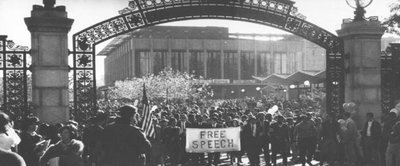
Photo Credit: Courtesy of UC Berkeley, The Bancroft Library. Group carrying “Free Speech” banner through Sather Gate [ca. 1965].
California Governor Edmund Brown Sr., gave authority to the police to proceed with a mass arrest. At 3:30 a.m. almost 800 students were arrested and taken to jail. They were released after a few hours behind bars. About a month later, the university brought charges against the students who organized the taking of Sproul Hall, resulting in an even larger student protest that all but shut down the university.
Eventually the University officials backed down. New rules were made for the free speech of students. The Sproul Hall steps were designated an open discussion area during certain hours of the day. The Free Speech Movement fostered open protest for students and others opposed to U.S. foreign policy; the FSM was followed by the Vietnam Day Committee, a major starting point for the anti-Vietnam war movement.
About the author
Syd Golston is a past president of the National Council for the Social Studies. She has served as a history teacher, school administrator and curriculum writer for many decades. She is the author of Changing Woman of the Apache, Death Penalty, Studies in Arizona History, and other publications and articles.





